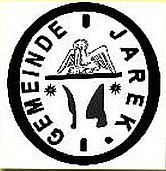the Serfdom at Jarek
The Historical Development of Jarek
(Bački Jarak, Tiszaistvanfalva) in Batschka
2. Jarek is subjected to Count Szechenj’s Patrimonial Rule
(The Serfdom at Jarek)
by Inge Morgenthaler (nee Schmidt)
translated by Eleonore Oreskovich
Jarek was originally founded in 1787 as a so-called Kameral community, as its settlement was achieved on a territory owned by the chamber of the court. So its inhabitants were free farmers, who were exempt from all charges like the tithes, robot (i.e. various kinds of compulsory services) etc. for ten years. They got their land on hereditary lease. When a community was founded, a so-called Urbarial (cultivation) contract always regulated the rights and duties of the patron, in this case the chamber of the court, and the colonists. In the contract with the “aerar” the inhabitants of Jarek thus had only rights and no duties for ten years. This was intended to give them an opportunity to take root and settle in their farms. Unfortunately, however, matters developed quite differently in the beginning. As soon as in June 1788, that was one year after the settlement, the inhabitants ran into great difficulties and almost died of hunger.
So they addressed a petition to the "aerar" to ask for support by providing bread and flour. In a list all the existing families are mentioned with the exact numbers of members and the quantities of cereals and flour each family had got. They committed themselves to immediately paying off the debt with the next harvest, i.e. in the same year. So the conclusion can be drawn that in the first year after their arrival the inhabitants of Jarek did not produce a harvest good enough to support them for a whole year until they could reap the next harvest. This makes it very clear that the following saying was true: For the first there is death, for the second misery, and (only) for the third bread. One can assume that in this case one generation was confronted with both, first death at Ruma and then misery in the second year at Jarek. But afterwards the situation slowly improved. The soil round Jarek was excellent and the harvests became better and better.
But very soon the next setback afflicted the settlers. In 1796 already, i. e. less than ten years after the foundation, Count Nicolas of Szechenj bought the domains of Jarek and Temerin. The count was a lieutenant colonel and "real privy councillor". He paid 80.000 guldens, but allegedly not in full, rather in several instalments, which he owed to the chamber of the court at Ofen. The agreeable years of free farming were over. A new contract was concluded with the count, of which there are only oral records.
It seems it became only valid after the first ten years had passed, i.e. in 1797. According to tradition, the settlers had to deliver the seventh part of their yield in the fields and the fifth part of their wine. The count also demanded his tribute of all the animals. All that was not so bad, but what was worse, was the robot, the services of all kind.
The farmers at Jarek had to accomplish the services of the "robot!' first, before they could work in their own fields. So sometimes their own harvest remained in the fields, while they were gathering the count's harvest. After threshing they had to deliver their tribute, which was much higher than the “tithe” in the countries where they came from. Ten years after settling they felt they had jumped “out of the frying pan into the fire”, as it were.
Then in 1798 a new Urbarial Contract between the earl and the community determined that from 1799 on part of the “robot” could be replaced by money. A hand robot amounted to 9 kreutzers and a “long cart load” to 30 kreutzers. What is interesting in this respect is that people without house or fields had to accomplish 12 "hand robots" at 9 kreutzers each, which had to be done in winter, "because in summer they used to scatter or change their residence”.
One "session"' (37 yokes of' field) was obliged to do: 16 carriage robots and 32 hand robots "'in natura”, the remaining 72 robots could be replaced by 9 kreutzers each. Of course the farmers owning half and quarter sessions only had to do a corresponding share. The merchants, workmen and servants, too, who had a house but no fields, could do their 18 robots at 9 kreutzers each and had to pay their "urbarial interest" of 55 ½ kreutzers cash twice a year. As they had no fields, they could not deliver any crops.
When all these obligations are added up, it is obvious that this patrimonial rule was a heavy burden, in particular the great number of robots. If Jarek had remained a "Kameral community", people would have had to pay interest and taxes, too, but the robots would not have existed without a direct noble landowner.
From these records one can imagine the relief' of our ancestors, when in 1849 at last robot and urbarial taxes i. e. patrimonial rule was abolished in the Danube monarchy. The inhabitants of' Jarek, however, probably paid the highest price for it of' all the villages in Batschka: the total destruction of' their village.
________________________________________________________________________________
List of sources:
Schmidt, J. et al.: Batschki Jarek-Jarek, Werbas 1937, pp. 20-22
__________________________________________________________________________________
Download for the "pdf-file":
__________________________________________________________________________________
